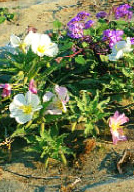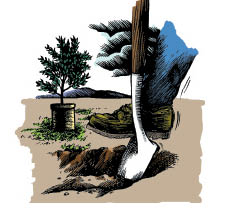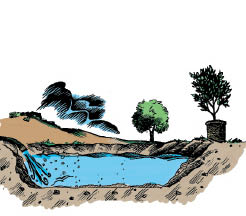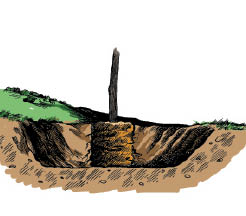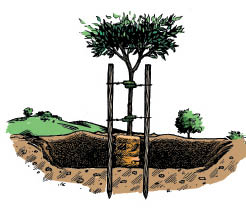Desert gardens can be lush and efficient. Contrary to the image of a desert landscape consisting only of cacti, boulders and gravel, many native and introduced dry-climate trees, shrubs, vines, ground covers and perennials have lush foliage, distinctive forms and showy flowers. In fact, a great many native Southwest desert plants provide even more color and interest over longer periods than their introduced tropical or subtropical counterparts.
About this Book
This book offers alternatives to high-water, high-maintenance landscapes in the Coachella Valley, typified by tall oleanders for screening and wind protection, formal trimmed hedges, large, thirsty canopy trees, expansive lawns and masses of spring annuals. New plants, new designs and new methods abound for area landscapes. Inside this book, you’ll discover ideas for gardens that are a harmonious blend of the old and new: subtropical plants in a private patio garden, set off by a small lawn for close-up viewing and barefoot pleasure. This type of small yet luxurious garden, called a mini-oasis, is located where it can be most enjoyed—up close to the house and outdoor living areas.
Those who prefer low-maintenance gardening in tune with the desert environment may plant native and introduced, low-water-use trees, shrubs and ground covers, with cacti and succulents for accents. Building earthen mounds and dry creek beds and adding naturalistic groupings of boulders is just one method of creating an appealing focal point that requires little water and care.
The permanent resident can plan and plant for year-round enjoyment, while the seasonal visitor can create gardens that bloom for selected months during spring. How these gardens are created is up to individual tastes and budgets.
High-water use plants such as hibiscus, azaleas and philodendron typically have soft tissues that require regular moisture to survive. Many subtropicals and tropical plants (nurserymen nickname them “the green stuff”) are native to regions receiving 50 to 150 inches of rainfall annually. In the high temperatures and often low humidity of Coachella Valley summers, few introduced plants of this kind can survive without regular applications of water and shelter from sun and wind.
Water-efficient natives and many introduced plants indigenous to low rainfall areas of the United States, Australia, Africa and the Mediterranean region can be grown successfully in the Coachella Valley. Such plants have the proven ability to survive on little moisture after they have lived a year or two in the garden. Their physical makeup allows them to develop leaves, branches and roots that conserve what water becomes available. Some adjust to dry spells by going dormant until the next rain or irrigation. Acacias, mesquites, palo verdes, African sumac, sennas, Texas ranger, crape myrtle and Mexican bird-of-paradise are part of this group. Subtropical bougainvilleas, strangely, flower better when plants are stressed for water.
Overwatering often creates serious problems. A fine line exists between the correct amount and excessive moisture. Although newly planted plants need regular attention to water needs, it is helpful to keep established plants on the dry side. Encourage deep and well established roots with deep irrigations. Plants are more self-reliant when they become conditioned to extreme heat, drying winds and cold.
The Economics of Landscape Water Use
Most of a homeowner's water use can be traced to use outdoors rather than indoor use. In fact, it’s estimated that up to 80 percent of urban water consumption in the Coachella Valley occurs outside the house.
To reduce water bills, many have opted for a “minimalist” landscape—a few cacti adorning decorative gravel. Others, recognizing the physical and psychological cooling affects of lush landscaping, plant tropical paradises. Unfortunately, these types of landscapes require huge volumes of water just to keep plants alive through Coachella Valley's scorching summers.
However, home gardeners can have the best of both worlds—lush plantings that thrive with an efficient irrigation program. The formula includes selecting water-efficient plants, grouping plants of similar water needs, and proper installation and maintenance of an irrigation system.
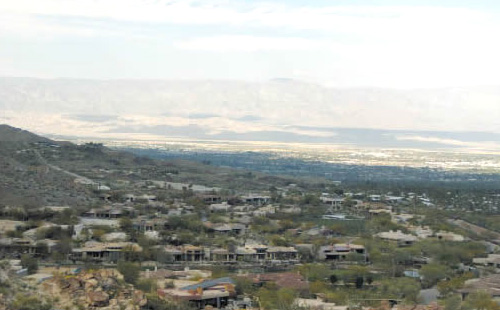
The Coachella Valley is home to a wide range of climate and soil conditions. Selecting adapted plants and planting them properly will go a long way toward achieving success with your gardens and landscapes.
Ingredients of a Desert Garden
Heat
When summer temperatures reach 90°F to 120°F and humidity is low, the toll on young plants can be severe in a number of ways.
Temperatures in the upper layer of soil can increase, quickly killing new, shallow roots of annuals and perennials. Signs are brown leaf edges and wilting of new growth. In areas of sandy, rapid-draining soils, plants suffer due to rapid drainage of moisture away from the root area.
High heat is most stressful on plants grown in nurseries located in more temperate climates along the coast, then brought inland to the desert. The sun’s intensity due to reflected heat from walls and windows adds to the stress, especially June through September with a western exposure. Details on how to develop a landscape that creates shade to reduce energy costs is described under "Landscaping for Climate Control".
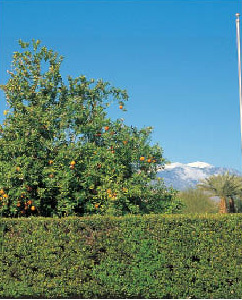
Cold-tender plants such as citrus are more likely to escape frost damage in landscapes located at the valley's highest elevations, or on slopes, which allows cold air to drain down and away from plantings.
Cold Temperatures
Coachella Valley frost patterns generally occur more frequently in lower elevations on clear and windless nights. Dry air temperatures drop about one degree for every 350 feet decrease in elevation. Cold air draining down mountain slopes usually settles in washes and in low pockets.
One sign of a potential for frost is when temperatures drop to 50 degrees before 9 p.m. in a clear sky and no wind. Average date for the first killing frost in the Coachella Valley is November 21, with the last frost around March 15.
During periods of low temperatures, tender plants can be protected by covering root areas with 2 to 3 inches of an organic mulch such as bark or aged, composted manures. Cold-tender plants in containers should be moved under the shelter of a wide overhang, patio overhead or canopy-shaped tree.
When selecting plants, be aware of their inherent hardiness to frost. (The cold hardiness of each plant described in this book is provided in the chapter Success with Desert Plants.) One of the best methods of learning which plants are cold hardy enough to use in any landscape is identifying established, healthy plants in older gardens in the surrounding area.
Wind
The flow of winds and accompanying sand is one of the most trying experiences for gardeners in the Coachella Valley. Plants can help curtail the bite of wind and sand in the form of dense windbreaks. They must be tall enough to reduce the wind’s force.
Wind patterns coming through San Gorgonio Pass fluctuate with westerly storms and coastal fogs. They are most prevalent during late winter and spring months. Dust and sand begin to move when the wind reaches 15 miles per hour (mph) or more. Mild dust storms may develop at 20 mph. Severe sand storms, which can create havoc with windshields, paint, people and plants, usually develop at 30 mph or more.
Local winds contrary to the westerly flow often are stirred by the development of low-pressure areas in the lower desert or are brought in by tropical chubascos, storms originating off the west coast of Mexico or southwest of San Diego.
If winds are common in your area, locate plants in the garden with the wind factor in mind. In general, windbreaks should be sited perpendicular to prevailing winds. Fortunately, the flow of sand decreases with each new development, which helps anchor sand dunes. Walls, fences, hedges, lawns, gravel and ground covers also reduce the problem.
Coachella Valley Soils
Experienced dry-climate gardeners realize the importance of managing soil, water and plants successfully. Fortunately, valley soils can easily be made more productive. In upland and eroded areas of the valley, soils are shallow and require more work to become acceptable for plant growth.
Caliche, also called hardpan, is a cementlike layer of calcium carbonate that accumulates below the soil surface. It can be a few inches thick to several feet thick, and is often encountered on slopes or flat areas. If a gardener's shovel bounces back when it strikes the soil, test for caliche. Pour vinegar or acid onto the area. If it bubbles, it’s caliche.
Soils in the Coachella Valley fall into definite categories. Areas west of Palm Canyon Drive and south of Highway 111 in Palm Desert are sandy to rocky due to the area’s alluvial structure. In some coves, wind-blown sand covers much of the ground. East of Palm Canyon Drive and north of Highway 111, most soils are predominantly sandy. In all instances, drainage of moisture is usually adequate.
Slow-draining soils can be found in La Quinta and points south. Here, gardeners must break through layers of silt or clay before water can drain. Silty sand builds up a crust that practically seals itself when water is applied. Commercially available soil penetrants made of sulfur compounds can be effective in combating this problem. Digging extra-wide planting holes and setting plants a bit higher when planting allows moisture to drain away from the plant’s crown. These methods are necessary in La Quinta and some lower elevation regions.
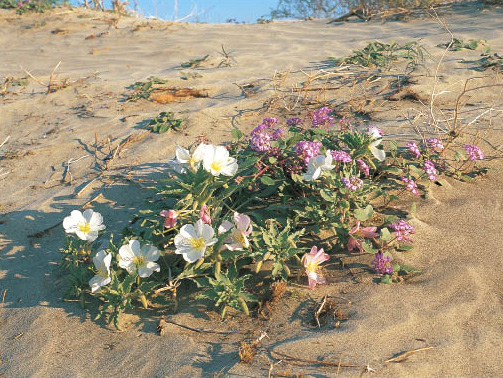 In many parts of the Coachella Valley, soils are almost pure sand. These conditions require that plants be given frequent irrigations due to the rapid drainage.
In many parts of the Coachella Valley, soils are almost pure sand. These conditions require that plants be given frequent irrigations due to the rapid drainage.
Organic Materials: Mulches and Additives
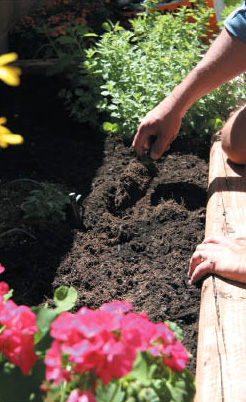 Mixed thoroughly into the soil, organic materials retain moisture and provide roots with a better growing environment. Plants growing in close proximity to one another such as vegetables, annuals and garden perennials benefit from amendments. Many soil amendment products are available at garden centers or nurseries, or you can make your own compost.
Mixed thoroughly into the soil, organic materials retain moisture and provide roots with a better growing environment. Plants growing in close proximity to one another such as vegetables, annuals and garden perennials benefit from amendments. Many soil amendment products are available at garden centers or nurseries, or you can make your own compost.
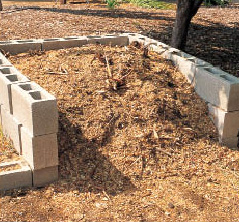 Compost is one of the best mulches and soil amendment available. In addition, a compost pile is excellent for recycling yard waste grass clippings, leaves, pruned twigs—that would ordinarily find its way to a landfill. This simple compost pile takes up little space and is easy to make with cinder blocks.
Compost is one of the best mulches and soil amendment available. In addition, a compost pile is excellent for recycling yard waste grass clippings, leaves, pruned twigs—that would ordinarily find its way to a landfill. This simple compost pile takes up little space and is easy to make with cinder blocks.
The addition of organic materials such as ground bark, composted manures and planter mixes aid desert soils. Mixed thoroughly into the soil, these materials retain moisture aerate clay soils and provide roots with a better growing environment.
Mulching and additives can: prevent soil crusting, curtail weed growth, reduce need for cultivation, reduce water use and lower soil temperatures. Materials generally available include packaged composted ground bark, cotton seed hulls and composted sawdust. In extremely windy areas, adding a layer of gravel helps to hold the mulch in place.
Working soil additives into planting beds makes sand and loam soils better at retaining water. Soil around new plants should be blended well with existing soil. Be aware that you must add enough material to substantially change the soil’s composition. The small chart under selecting and buying plants will give you a guide as to how much a 2-cubic foot bag of soil amendment will cover. Prepare soil a few weeks before planting to allow additives to better incorporate into existing soils.
The pH of desert soils is often alkaline, caused by an accumulation of sodium and calcium. Due to low rainfall, these two elements don't adequately leach, or wash away, if soils are heavy. Fertilizer such as ammonium sulfate or soil sulfur, worked thoroughly into the soil, helps lower the pH, typically to 7.2. Deep watering in soil that has good drainage also helps alleviate the problem.
Salinity, or salts, can be a problem in heavy soils if there is not enough rainfall to move salts down and away from plant roots. Farmers flood fields to leach salts into underground drains. Adding iron sulfate or soil sulfur to planting areas can help the residential gardener combat salt buildup.
Many desert areas on alluvial slopes, areas of young, rocky soils at the base of mountains, have deep strata of decomposed granite, commonly referred to “D.G.” These soils have been created by extreme water action of storms and the resulting runoff. Drainage is rapid. Plant roots grow well in such soils if given adequate moisture. However, when dry, alluvial soil is difficult to work. Mixing in soil additives and adding water to soil before digging and planting can help.
Landscaping for Climate Control
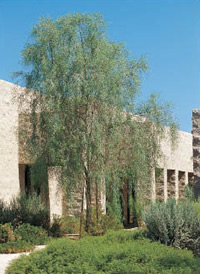 Research shows that trees and shrubs strategically located around buildings dramatically reduce cooling costs. This tree is Acacia aneura, mulga acacia.
Research shows that trees and shrubs strategically located around buildings dramatically reduce cooling costs. This tree is Acacia aneura, mulga acacia. 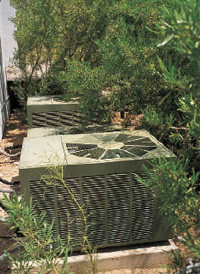 Shading air-conditioning units can reduce their workload, making them more energy-efficient.
Shading air-conditioning units can reduce their workload, making them more energy-efficient. When you live in a hot desert climate such as that of the Coachella Valley, you probably spend more money to cool your home than to heat it. And, as mentioned in the introduction, outdoor water use can be as much as 80 percent of a home’s water consumption. Energy and water prices have been increasing and are likely to continue, prompting residents throughout the Southwest to find ways to conserve them both. There are some simple ways to conserve energy by using water-efficient plants in combination with appropriate landscape and irrigation system design.
How Plants Modify Climate
You’ll quickly feel the drop in temperature on a hot day when you walk beneath the shade of a dense tree. Trees, shrubs and ground covers can greatly reduce cooling loads of buildings in hot, arid climates by modifying air temperatures and solar heat gain.
You can design or retrofit a landscape to keep cooling costs reasonable. Locating trees, shrubs and vines so they will shade homes can effectively lower the energy required to cool a home.
Plants also cool air around homes through the process of evapotranspiration. The evaporation of moisture at the leaf surface cools the air around the leaf. Research has shown that trees and shrubs placed in key locations around a home can reduce cooling requirements up to 24 percent. A mature, wide-canopy, shade tree placed to shade the south and west walls and roof of a home can cut cooling costs up to 42 percent.
It is necessary to know where the sun is in the sky when temperatures are at their hottest. The goal is to position plants so they will block the sun’s rays. The path of the sun during summer is much higher than it is during winter. This means that summer sunshine tends to warm the east and west walls, as well as the roof. Winter sunlight strikes mostly south-facing walls.
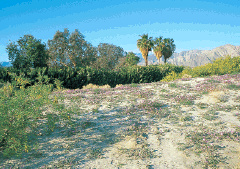 Oleander is a common windbreak in the Coachella Valley, but a recent viral infection has caused many stands to decline and die. See a list of other suitable windbreak plants.
Oleander is a common windbreak in the Coachella Valley, but a recent viral infection has caused many stands to decline and die. See a list of other suitable windbreak plants.
Trees—Trees provide direct shade for outdoor spaces, walls, windows and the roof area of a home. The choice of tree types for summer shade could be either evergreen, where trees remain in leaf all year, or plants that are deciduous, when leaves drop and branches are bare in winter. In colder areas, it’s a benefit to use deciduous trees. The bare branches during winter allow warming sunlight to reach walls and windows.
Keep in mind that many trees take five years or more to provide any measurable shade. Some deciduous trees provide a shade canopy cover twice as fast as some evergreens. (Note: The relative growth rate of many trees are provided in the descriptions in chapter three.)
Ground Covers—Ground covers decrease heat around a structure and on walls and windows, thereby reducing cooling costs. In place of a sea of gravel, a landscape composed of ground covers, a small lawn and shrubs will greatly reduce heat gain around a home. The benefits of this cooling outweigh the additional cost of water to establish and maintain the plants.
Windbreaks and Hedges Help Control Climate
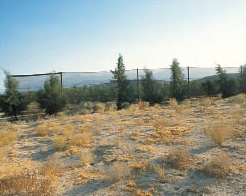
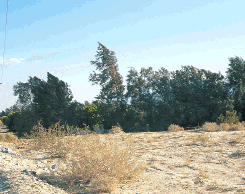
The photos above are the same windbreak near Indio, taken 7-1/2 years apart. Screening was used the first years after planting to protect citrus until trees attained sufficient size.
Windbreaks have long been a part of the history of the Coachella Valley. In the past several decades, thousands of acres of orchards, date groves, vineyards, vegetable crops and small villages were developed from the Salton Sea to Palm Springs. Windbreaks of many kinds were planted to reduce the impact of wind and blowing sand. For example, without the blow-sand control offered by the rows of tamarisk windbreaks planted by Southern Pacific, railroad tracks would be quickly covered by sand dunes.
Development in the Coachella Valley continues to claim large acreages of sand dunes up to and across Interstate 10. The need for controlling blowing sand and dust becomes even more important as government laws for clean air controls are implemented to reduce the impact of blowing sand and dust.
Windbreaks also help control the burning and desiccating effects of the intense summer sun by creating cooler, sheltered small climates called microclimates. The single, double- or triple-hedge creates a more gentle climate around a home that allows more fragile plants to grow and thrive.
Windbreak Basics
Consider the intensity of the afternoon sun, heat and direction of wind when you locate trees and hedges for windbreaks, hedges and screens. One clue is to notice how plants are shaped (leaning) due to prevailing wind patterns.
Divert wind with height and density. Tall trees—to 40 feet or more high—can reduce wind velocity as much as 50 to 200 yards downwind. Study existing windbreaks in the region that are effective in helping control and divert wind. How are they placed, and which plants are being grown? What is the spacing between plants?
Acacia aneura, Mulga Acacia
Brachychiton populneus, Bottle Tree
Ceratonia siliqua, Carob
Cupressus arizonica, Arizona Cypress
Cupressus glabra 'Gareei', Rough Bark Cypress Eucalyptus microtheca, Coolibah Tree
Eucalyptus spathulata, Swamp Malee
Pinus eldarica, Afghan Pine
Pinus pinea, Italian Stone Pine
Rhus lancea, African Sumac
Multiple-trunk trees generally maintain better vertical growth under the stress of wind. Even with dense foliage, pines and cypress withstand heavy or constant winds with a rugged persistence.
All windbreak trees must have deep irrigation to survive. Drip irrigation has proven to be ideal in helping trees develop deep roots.
A triangulated pattern with 12- to 18-foot spacing of trees, with lower ground level 10- to 12-foot shrubs and conifers with great density, can create a strong barrier against wind.
_fmt.jpeg)
It helps to understand how exposure—north, south, east or west—influences plant growth. South and west exposures are much warmer, plus reflected sun in these exposures can quickly damage unadapted plants. The ocotillo and bougainvillea shown in this home landscape will accept the intense heat of a western exposure.
Grouping Plants by Sun and Water Need
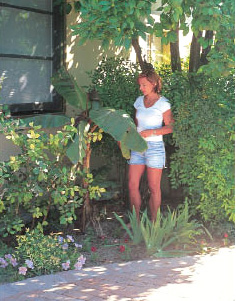
Microclimates, the small climates around your home, can be used to your advantage. This protected spot is an ideal location for cold-tender plants.
Plants that are efficient users of water employ many tricks to stay alive. Some go dormant in the summer. Others have modified leaves that conserve available moisture. Leaves may have a small surface area; be it thick, waxy or leathery; or fuzzy or hairy. Other plants have green trunks and branches that carry out photosynthesis. Still others have well developed, deep root systems designed to absorb available moisture. Some have seasonal adaptations. For example, deciduous plants may require more water in summer, but survive on much less water in winter.
Often, a plant’s water needs change as they begin to mature. Many fast-growing young plants require a lot of water the first few years, but as growth slows with age and a deep root system develops, they may require only occasional deep watering.
It is important to keep in mind that not all native plants use less water than plants introduced from another region. Some plants native to riparian (streamside) areas, such as cottonwoods, are high water users with aggressive roots.
Matching the Plant with the Exposure,
The Exposure with the Plant
Plants are born with inherent tolerances to light and heat. When you have a location at your home in mind as to where you want to place plants, understand the exposure—north, south, east or west—and select a plant that accepts the growing conditions there. This method usually works better than buying a plant you like and trying to find a proper exposure to match. Here are the common exposures, and what plants will have to tolerate to survive:
South and West—The west exposure with its intense afternoon sun is by far the most difficult growing location. During the summer months the searing heat can overcome many plants. A south location has the benefit of being warm in winter, receiving sunshine during all seasons. Only sun- and heat-loving plants will thrive when planted in a south or west exposure.
East—The east side of a building or wall is probably the ideal exposure for most sun-loving plants. Some plants may be heat-tolerant, yet are easily burned by direct, hot afternoon sun. Such plants will thrive along the east side of a structure, where forgiving shade is cast during the afternoon. Plants that tolerate some shade also belong in this exposure.
North—The north side must be used for shade-loving plants, but during midsummer months, it, too, receives some sun. Certain plants in this north exposure may need protection from the afternoon or morning sun during this period. Plants with limited heat tolerance belong on the north side of structures or trees. When working with this group, be aware of any reflected heat from adjacent sidewalks, driveways, streets, masonry walls or water features.
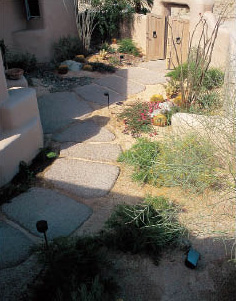
Shade cast by trees or buildings create cooler, more protected planting sites. Eastern exposures are well-suited for plants that wilt in full sun.
Expand planting areas for the most sensitive plants by taking advantage of shade from trees and structures. The filtered shade of a canopy-forming tree such as many acacias, mesquite or palo verdes becomes an ideal place for plants prone to sunburn. This is especially true if they are in containers, which eliminates the problem of roots competing for water. Extremely sensitive, cold-tender plants should be potted so they can be moved to appropriate protection as seasons change. These plants must be located carefully, considering the variables of their exposure, spacing, cold tolerances and water requirements. Not all are thirsty!
Hydrozoning: Grouping Plants by Water Use
Grouping plants according to their moisture needs is called hydrozoning. This helps in the design and application of drip-irrigation systems, which are just as valid for low-water-use natives and other dry climate plants as for subtropicals requiring high water applications.
Plants with the highest water use should be closest to the area where you spend the most time outdoors, such as planting areas near patios and at home entrances. This high-water zone is the prime location for annuals and luxuriant, water-thirsty subtropicals and other high-water-use plants. Some people also call this a mini-oasis, creating a cooling, colorful oasis of plants.
Vigorous, unfussy shrubs and trees, such as the sennas, Texas rangers and mesquites, are planted in the moderate-water zone.
In dry climates, the low-water zone is usually farthest from the house and water supply. Plants are not usually viewed close up. For this reason they can have coarser textures, and do not have to be maintained at optimum water applications.
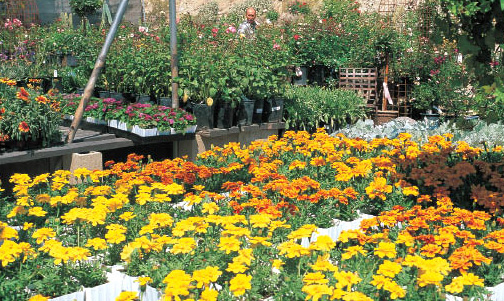
When shopping for plants, keep in mind that smaller plants generally establish faster and transplant easier than larger plants of the same species. Look for uniform, healthy growth, and avoid plants that are root bound.
When buying plants, keep in mind that extremely large plants such as boxed trees take much longer to become established than a plant set out from a 5-gallon or 15-gallon container. Unless extremely slow-growing by nature, a smaller plant usually establishes itself faster than a larger one, and may even outgrow it. A smaller plant has the added advantage of reduced cost, and usually reacts more favorably to transplanting than a larger plant of the same species.
100 plants . . .
Spaced 4 inches apart will cover 11 square feet.
Spaced 6 inches apart will cover 25 square feet.
Spaced 8 inches apart will cover 44 square feet.
Spaced 10 inches apart will cover 70 square feet.
Spaced 12 inches apart will cover 100 square feet.
Spaced 15 inches apart will cover 156 square feet.
Spaced 18 inches apart will cover 225 square feet.
How Much Soil Amendment do you Need?
2-cubic foot bags . . .
1 bag covers 175 square feet 1/6 inch deep.
1 bag covers 54 square feet 1/2 inch deep.
1 bag covers 27 square feet 1 inch deep.
Mail-order plants—These are often shipped from suppliers in the Midwest or East, and generally arrive too late in the growing season for Coachella Valley gardens. Order only if the shipper will guarantee delivery for planting in January or February.
Bare-root plants—Roses, grapes, and selected fruit and shade trees are generally available “bare root” in nurseries from December through February. They are graded by trunk diameter and height. Medium-sized plants are preferred for planting.
Flats, pots, packs and quarts—Nurseries usually supply annuals, perennials and ground covers in these types of containers. Avoid plants that seem overgrown for their container, that are heavy with mature flowers, or are too succulent. Select plants with fresh growth and are adorned with buds ready to bloom.
Gallon, 5-gallon, 7-gallon and 15-gallon containers—Pass on plants that have heavy pruning cuts, or are oversized or root bound. If containers are filled with roots, plants are probably stunted and seldom develop normal growth. (Trees often become overgrown in containers.) Also avoid plants with sunburned trunks, cracked trunks, severely trimmed branches or binding tree ties. The best and healthiest specimens will have fresh, new, vigorous growth.
24- to 60-inch boxed trees—These are often field-grown, then transplanted into boxes to establish and regrow.
When shopping for plants, consider the following important aspects of knowing and understanding plant performance. Get to know:
- Size and width at 5 years, 10 years, maturity
- Rate of growth: slow, moderate, rapid
- Flowering habit, bloom period
- Foliage type: coarse, medium, fine
- Water requirement: low, moderate, high
- Nutrient needs: native plants require minimum
- Preferred soil type and soil drainage requirement
- Exposure: reflected sun, sun, filtered shade, shade
- Hardiness to cold, heat, wind
- Relationship to other plants: “plant partnerships”
- Ideal planting season
When you prune, you are directing plant growth. It is important to keep some key rules in mind that will help in maintaining or modifying the plant’s structure.
Through all seasons in Coachella Valley, plants have a greater vitality when given reasonable care and supplied with adequate moisture. Pruning, shaping, thinning and dead-heading flowers become important regular aspects of plant maintenance—more important than many gardeners realize.
There is a lack of understanding by many people concerning how to maintain water-efficient plants in dry climate regions. Proper pruning, thinning and trimming promotes healthy, attractive growth, maintains a natural form and reduces garden work, as well as debris.
Some Pruning Basics
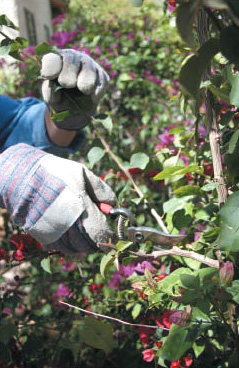
Prune carefully to direct growth and to control wayward branches. Gloves help this gardener protect his hands from the sharp thorns of bougainvillea.
Good pruning and shaping techniques begin with plant selection. The gardener must consider rate of growth and mature size; plant form and texture; location related to sun, shade and soil type; flowering habit and spacing for width, height and proximity to structures, walks and pedestrian traffic areas.
Poor pruning practices are often perpetuated by a lack of knowledge about plant growing habits and flowering periods. Contributing to the problem is the over-planting of many new gardens, done to achieve an immediate mature effect.
Follow these guidelines to help gain an understanding of this most misunderstood gardening practice.
- Cold-hardy plants can generally be pruned in late fall to early winter. Subtropical and tropical plants respond better when pruned in late spring and early summer.
- Remove broken, diseased or dead wood from trees and shrubs at any time.
- Remove crowded stems and weak growth to help plants develop balanced structure and form.
- Naturalistic pruning—light, selective removal of branches and limbs, allows plants the opportunity to grow as nature intended. Hedge-sheared plants are robbed of their individuality, flowers and natural beauty.
- Cut stem stubs close to a main stem to aid healing.
- Nip tips of new growth to increase bushiness.
- Fast-growing trees such as the many acacias, elm, eucalyptus, mesquite, palo verde, and bottle brush need thinning to reduce chances of wind damage.
- Remove sucker growth on trees to prevent branch growth in the wrong locations. Pull, rather than cut, for best results.
- Pruning citrus trees requires a special approach. For detailed information see "Pruning Citrus".
- Pruning tools work much better when you keep them sharp. Also be sure to use the right size pruning tool for the job.
- Better plant shape and regrowth develops when plants are pruned gradually over a period of time in contrast to once-a-year heavy pruning. As a rule, remove no more than 20 percent of the plant’s foliage at any one time to avoid stress and sunburn of trunk and branches.
It is seldom too late to correct past pruning errors. Plants have a great ability to recover from poor pruning. You can improve their appearance with time and adequate care.
Topping Trees
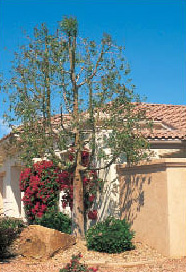
Avoid topping trees. It ruins the tree's form, shortens its life and may cause it to become a hazard.
Tree topping, also called heading, refers to the removal of major portions of the tree’s crown by cutting branches to stubs or to the main trunk. This type of negative pruning is most conspicuous on eucalyptus and mulberry trees.
This mutilation results in clusters of stems emerging below the stub cuts, creating excessive, small, weak branches that later become vulnerable to breakage. The new growth can increase wind resistance, as the mass of branches become a “sail” in the wind, often causing extensive damage or loss of the tree. On a small scale, topping creates openings for invasion of rotting organisms. Stubbing branches also upsets the entire growth pattern of the tree. Over a period of time, the tree will generally decline in beauty and effectiveness, with a decrease in monetary value by 20 to 50 percent.
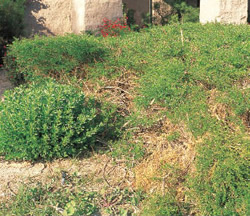
You can improve the appearance of many ground covers by cutting them back every few years, preventing dead stems from mounding. Baccharis at left was cut back, shows fresh new growth.
The Irrigation and Pruning Connection
The relationship of irrigation and pruning is a close one. The amount of water applied directly affects the amount of pruning needed. Overwater, and growth can be too lush and succulent. Underwater, and plants become stressed, reducing healthy growth and inviting attacks from pests and diseases.
Proper irrigation is one of the most important elements of growing healthy trees. Deep watering with drip irrigation that places moisture deep in the root zone is recommended. It can be provided by an irrigation schedule that takes into account the size of a tree and its root system. Trees in turf areas without drips or bubblers often have problems related to surface roots, and lack deep roots to help stability and resistance to heavy winds.
In many parts of the Coachella Valley, sandy soils and rock-and-sand soil combinations are common. They have excellent drainage qualities, but tremendous amounts of water must be applied frequently to keep plants alive when temperatures are high. Rapid soil drainage and frequent irrigation leaches (washes) plant nutrients, particularly nitrogen, away from plant roots. This results in a need to replenish these nutrients more often.
Because of the rapid leaching of nutrients from the root zone, you get better results by applying fertilizers more often and in smaller doses. Adding soil amendments in the form of organic materials is also useful to counter nutrient loss from leaching. Ground bark and compost are examples of materials to add to the soil to help retain valuable moisture and nutrients.
The availability of fertilizers packaged for specific plant types and uses reduces the need to do your own mixing of nutrients. Commercially available citrus food, rose food, palm food and lawn fertilizer make fertilization programs simple. In all instances, closely follow all product label instructions.
After many years of testing in commercial projects and in nursery growing operations, slow-release fertilizers have become useful products for the home gardener. They can be added safely to the soil mix at planting time in close proximity to plants’ roots. They provide proper nutrients over many months, reducing time and expense while improving plant growth.
Fertilizing According to Plant Type
New plantings of shrubs and trees will accept a well-balanced application of organic plant food by the second or third month after planting. Azaleas, camellias and gardenias generally need acid-type nutrients when plants complete their bloom cycle. Continue applications monthly through summer. Citrus trees maintain a good growth pattern when fertilizers are applied regularly from February to the first part of September. Roses need a steady diet from early spring into late fall, based on their bloom cycle. It is helpful to remember that when roses complete a bloom period, it’s time to apply a balanced rose food.
Lawns respond with vigorous growth when given high nitrogen fertilizers. For Bermudagrass lawns, provide a monthly application through the warm months. For ryegrass, fertilize through the cool months. Fertilizing properly helps keep a lawn healthy, and helps prevent weeds from becoming established.
Deep-rooted trees often require deep applications of nutrients. This can be achieved by placing three or four slow-release tablets into 12- to 18-inch-deep holes dug into the soil around the dripline. Deep watering is also essential.
Annuals, perennials, and ground covers often have shallow roots, so pelletized types of fertilizer are safest to apply. Neglecting fertilizer applications can cause slow growth to the point where plants become stunted.
Liquid organic fertilizers are easy to use. The reaction period is fast and safe, and they can be applied more often. Dichondra lawns, ground cover plantings, and newly planted annuals and perennials respond readily and favorably to liquid fertilizers. As with all fertilizer products, read and follow product labels carefully.
As mentioned, continuous leaching can cause problems in availability of nutrients in the soil. Plants show a need by a yellowing of leaves, called chlorosis. It can be caused by the lack of available iron or other elements in the soil. In such cases it can easily be identified: Leaf veins remain green while the rest of the leaf turns yellow. Apply iron chelates as soon as it is noticed.
Fertilizers continue to be improved by manufacturers. They are becoming more specialized for various kinds of plants. Seek advice from your nursery on the current fertilizers that may be best suited for the plants you are growing.
Mulching to Save Water (and More)
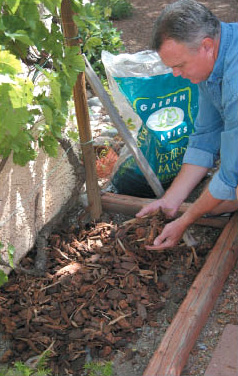
A simple layer of mulch over the root area of plants helps in many ways. It conserves moisture by reducing evaporation, insulates the upper layer of soil, and cuts down on weed growth. Over time, an organic mulch will decompose, helping improve the soil.
Covering the soil with a layer of organic material prevents soil from crusting, which reduces the need to cultivate. Mulching also improves soil structure and lowers soil temperatures.
A layer of mulch should be about 3 inches thick. In large open areas, mulches can help reduce weed populations and add a decorative covering.
Mulches cool the upper layers of soil. The sun can bake the top inches of soil, damaging fragile roots that grow near the surface. Soil temperatures in mulched areas can be 8 to 10 degrees cooler compared to soils without mulch.
Mulches maintain uniformity of soil moisture more readily. In areas where a silty layer of soil affects the flow of water into lower layers of soil, a mulch reduces the air-tight silt layering, allowing moisture to penetrate to lower layers.
Materials that are generally available as mulches include organic matter such as ground bark, composted redwood sawdust and compost. Gravel or rock are coverings and do not improve soil structure. Bark chips and bark chunks can be used, but when kept moist, they turn an unattractive gray color in just one season. Strong winds, common in the Coachella Valley, can also blow them away from plantings. Animal manures are not satisfactory as a mulch due to problems with salt accumulation. They should also be well-composted before applying around plants.
As mulches decompose and combine with the soil, it is necessary to replenish them. Mulches that tend to remain soggy should not be allowed to come in constant contact with stems and trunks of plants, or fungus and disease problems may occur.
In many cases you can identify insect culprits by the damage they inflict on leaves and other plant parts. Fortunately, the number of pests in the Coachella Valley are seasonal and the majority of native shrubs, trees and ground covers are bothered by few, if any, insect invaders.
Sucking Types of Pests
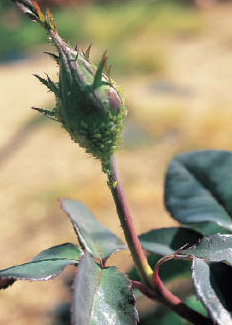
Be on the lookout for aphids in early spring. They love to attack tender new growth.
Aphids leave their mark with curled leaves, distorted new growth and damaged flower buds. Their first arrival coincides with the burst of new growth in the spring, their most vigorous period of activity. Aphids come in many colors—black, green and yellow—and can literally cover lush tips of new leaves and stems.
Because injury is caused by their sucking of vital juices, you can control them with sprays. Sprays can be systemic, which means that they are absorbed by the plant and kill the pests when they tap into the sap of the plant. Other sprays kill insects by contact.
To avoid killing natural predators such as ladybird beetles (ladybugs) with an insecticide meant for aphids, you can wash off the pests with a blast of water from a garden hose. Spray as soon as you see evidence of their activity and repeat twice weekly while pests are active
Aphids prefer roses, some annuals, new growth on pyracanthas, oleander and even citrus. Vigorous-growing plants such as oleanders usually have no problem outgrowing their damage.
Spider mites cause leaves to be mottled, stippled and sometimes turn yellow. Most damage occurs with arrival of hot weather. Shaking suspect leaves over a clean sheet of white paper will show spider mites if they are present. They are so tiny that a magnifying glass must be used to see them in detail.
Mites attack citrus, and are common pests on conifers such as Italian cypress and prostrate junipers. Follow the same controls as with aphids. If infestations are severe, treat with a miticide. However, the best defense is a good offense. Keep plants watered properly, not too much or not too little, and they will be more healthy and resistant to pest attacks.
Chewing Types of Pests
Thrips are practically invisible, but leave behind their marks on the surface of leaves and fruit, causing them to form streaky, distorted scar tissue. Their most active period begins during the warming trend in early summer and again in early fall. Controls are the same as with aphids and spider mites.
Beetles, caterpillars and grasshoppers leave behind ragged chewed-out spots on leaves and flower buds. Some critters even roll up leaves; others cut off stems of succulent annuals below the soil line.
Many systemic controls are available. Other controls are sprayed on leaves and stems to kill on contact.
Lawn moths and their caterpillars are only evident when you see the moths flying around at dusk over the grass, preparing to lay eggs. The caterpillars that hatch from these eggs do the actual damage. Apply controls to the grass. In severe or questionable situations, contact a local nursery for the most current controls available. Improvements of sprays and dusts are being made continually.
Caution: The incorrect use of pest control chemicals can be extremely dangerous and hazardous to plants, pets and people. Read all product labels and follow instructions carefully.
Preventing and Controlling Diseases
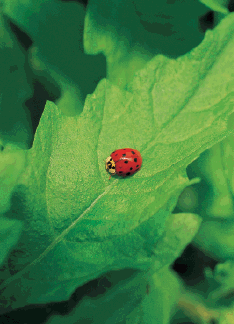
Ladybird beetles (ladybugs) are beneficial insects, preying on insect pests such as aphids (left).
A preventive control program is probably the best method to reduce fungi or other plant diseases on susceptible plants. Major plant diseases in the Coachella Valley often involve citrus, oleander, roses and annuals such as petunias, vincas, and zinnias.
Poor soil drainage—made worse when excessive soil is piled high on the crown at the base of a tree—as well as sunburn damage to stems, can bring on gummosis disease on citrus. Indications of this disease are the formation of lesions in the bark near the bases of stems. Discolored sap may flow from the infected area. For controls, see Citrus.
Overhead watering of roses in the evening hours during periods of high humidity can bring on mildew. You’ll see it as a gray, powdery covering on new foliage and buds. Apply sprays or powders to treat at first sight. Avoid by watering at ground level and during early morning. Zinnias and grapes are also susceptible to mildew. It may be helpful to grow plants or varieties that are less susceptible. Contact your nursery or cooperative extension office for recommendations.
Oleander leaf scorch deserves special mention. It’s a bacterial disease believed to be spread by the glass- winged sharpshooter, a native leafhopper insect. Symptoms are brown leaf tips, with dieback first spreading to branches, then to the entire plant. The bacteria shuts down the plant’s water-conducting system, eventually killing the plant. Currently, plants 20 to 30 years old are most affected. In addition to oleanders, other plants may be susceptible. At this time there is no cure. Contact your local cooperative extension service for help in identifying this disease.
When you engage in a constant struggle to control weeds, you need to evaluate the costs, methods and effectiveness of using chemicals and their impact on the environment—both local and the entire world.
It’s important to control weeds in gardens and landscapes to reduce aggressive competition for water, garden space and nutrients. A weed-free garden is more attractive and more healthy.
Several options are available to control weeds. They include hoeing, cultivating, mulching to reduce their numbers (and make them easier to remove), pulling by hand, applying chemicals and using the solarization method, described below.
Above all, try to keep weeds in check by controlling them on a regular basis. If you see them, pull them. One of the best times to engage in a weeding session is right after a decent rain. Then, when the soil is moist, weeds can be pulled fairly easily, roots and all. Don’t leave weeds on the ground where their seeds can continue the cycle. Toss them in the trash.
Using the Sun for Weed Control
Solarization uses the sun to kill weed seeds. It is a simple but effective weed control method that is even used by commercial vegetable growers in the Southwest. A similar process applies to the home garden as well.
The process begins after the weather heats up—late spring to early fall. Soak the area to be treated so moisture reaches 6 to 12 inches deep. Cultivate soil 4 to 6 inches deep. Lay clear plastic over the area. Shovel soil over edges of the plastic covering to seal in heat and to hold the plastic in place. Allow seeds time to germinate, which will take 2 to 4 weeks. The build up of heat under the plastic quickly kills weed seedlings. After seedlings have been killed, remove the plastic and dead growth. Work the soil well before planting your wildflowers, vegetables, annuals and perennials.
For weed control methods that require chemicals, seek advice at your nursery for recommendations on products and application methods. Grassy weeds such as Bermudagrass, nutgrass or Delhigrass require a material that is absorbed into the root zone. Broadleaf weeds such as Russian thistle, spurge and others have spray materials formulated specifically for their control. In all cases, apply chemical applications carefully on windless days to prevent harming humans and pets. Follow all directions on the product label.
Month-by-Month Gardening Calendar for the Coachella Valley
January
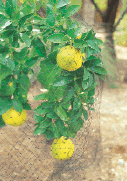
January: protect citrus fruit.
January is usually our coldest month, with pleasant days and cool nights. There’s even a chance for frost.
Lawns overseeded with ryegrass need regular moisture and weekly mowing. If yellowing occurs, apply high nitrogen fertilizer.
This is the last opportunity to plant bare-root roses, grapes and deciduous fruit trees. Prune your roses and deciduous fruit trees this month. By now, red bird of paradise have gone dormant. Cut back stems to about 18 inches above ground level.
Plant cool-season vegetables and herbs.
January is the ideal month to make additions or changes in the garden while temperatures are kind. It is a good month to retrofit your garden. (See also December.)
Now’s the time to transplant cold-hardy plants, including perennials.
Check tree stakes and ties for support against strong winds common in the spring months.
February
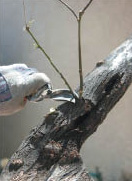
January: prune when plants are reaching dormancy.
Warming trends this month set the stage to fertilize citrus trees. Water annuals and perennials diligently. Control winter weeds.
Complete pruning of roses and deciduous fruit trees.
February is an excellent time to plant shallow-rooted ground covers, native plants and other low-water use plants. Hold off planting frost-tender plants such as citrus and bougainvillaea until next month, to avoid a possible late frost.
Continue to plant winter vegetables.
Check plants for aphids or other pests and control as soon as you notice them.
Begin deep root watering of trees in anticipation of spring growth surge.
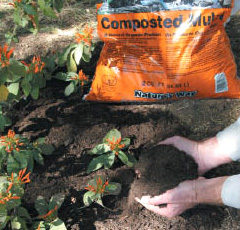
March: Add mulch to conserve soil moisture.
March
The warm, mild weather of March prompts rapid and excessive growth of plants as well as insect pests. Roses, citrus and hibiscus are most susceptible. For aphids, wash them off with a strong jet of water. If this does not work, check with your nursery for a safe product. When thrips attacks citrus, they cause leaves to curl and scar fruit rind. Control is difficult. Take some comfort in the fact they will be gone soon. White flies are attracted to bright yellow. Place a sheet of yellow cardboard covered with petroleum jelly near susceptible plants to capture them.
To reduce fruit set, spray olive trees with a flower control spray while trees are in bud. Spray again when two-thirds of blossoms are open.
Fall-planted annuals reach peak bloom in March. Thin any crowded plants. Pinch back stems of snapdragons to cause new flowering stems to develop.
Apply crabgrass control to lawns.
Water needs increase for all plants as temperatures rise. Reset irrigation system amounts to provide more moisture. Consider purchasing a weather-based irrigation controller. It adjusts to conditions automatically.
Fertilize citrus, lawns, perennials and vegetables.
As flowering bulbs complete their bloom, remove old flower stems.
Plant landscape plants as soon as possible this month if you missed the fall planting season to help them to become established before summer heat arrives. Most Southwest desert native trees and shrubs do better without fertilization.
April
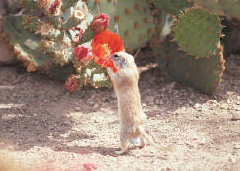
Animal pests will want their share of spring flowers.
This is a great garden month and a time when the color season reaches its peak. April is also the ideal planting month for tropicals that are sensitive to cold such as bougainvillaea, hibiscus, lantana, cape honeysuckle and citrus.
Begin preparing soil in sunny beds to plant warm-season annuals such as marigolds, periwinkle and zinnias.
If periwinkle plants wilt and die, they likely have periwinkle wilt. Remove and discard plants.
Bermudagrass should be “encouraged” this month. If lawn was overseeded with winter ryegrass, cut rye low, which slows its growth, giving the dormant Bermuda the opportunity to regrow. Apply high-nitrogen fertilizer and water it in thoroughly.
As temperatures increase in the latter part of April, winter annuals will begin to lose their vigor. Remove plants as they fade or begin to die out.
Prune and thin sennas and Texas rangers into a natural form after flowering ceases. Your goals are to control growth, yet increase spread of plants and create additional wood for the following flowering season.
If you didn’t do so in March, review irrigation schedules (both mechanical and hand watering) and increase water to accommodate the increase in temperatures.
Deadhead (remove) spent flowers and fertilize roses after each bloom period for a final crop before hot weather.
Control weeds and Bermudagrass in flowerbeds. Don’t put this off; regular weeding prevents disaster.
May
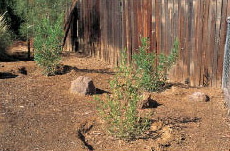
May: Extend watering basins for summer irrigations.
May brings the first touch of summer, which begins to affect plants in many ways. The heat also slows human activity in the garden this month.
Review drip irrigation systems and flush out lines to eliminate dirt and debris that could clog lines or emitters. Increase watering amounts to about twice the amount you were watering last winter. For more specific amounts, see the chart on irrigation.
Apply organic mulches beneath the root areas of citrus, roses and perennials while temperatures are moderate enough to allow work in the garden.
Winter and spring annuals have faded, while many perennials such as coreopsis, gaillardia and rudbeckia are developing vigorously and just beginning their color season.
Clean up dead leaves and faded flower stalks on daylilies. You can remove spent yucca and aloe flower stalks once they are past bloom, but some gardeners leave them for the interest they provide when dried.
Apply acid fertilizer to azaleas, camellias and gardenias. With watering schedules increasing, observe plants for chlorosis—yellowing of leaves. This probably indicates lack of iron. Acidify the soil so plants can absorb iron.
If cold-tender plants were damaged by frost last winter, recovery should be well underway. Now, new growth on live stems should tell you which stems and branches are dead. Prune them to live tissue.
June
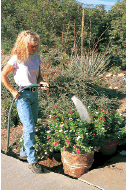
June: water regularly, particularly plants in containers.
Summer has arrived with a vengeance. It is important to maintain a regular irrigation schedule.
Prune to control rampant growth of oleanders, citrus, lantana, bougainvillaea and hibiscus. Thin excess interior growth of mesquites. Remove crossing branches of palo verde trees.
Remove Bermudagrass that has invaded planting beds. Pull it by hand, or spray with a product containing glyphosate. Take action as soon as you notice it; wait too long and it can become difficult to eradicate.
Roses, shrubs and young trees benefit from the addition of a 3-inch-thick layer of mulch. It helps keep roots cool and slows evaporation of moisture from the soil.
Palms and cacti transplant most readily in hot weather. When moved early in the warm season, plants recover with good growth, responding to heat and deep irrigations in well-drained soil.
Provide shade to protect sago palms from direct sun.
July
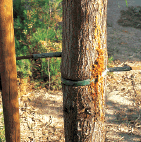
July: Check plant ties often.
With highs ranging from 105°F to 120°F, it should be no surprise that gardening practically comes to a standstill this month. Any gardening task seems to become a gigantic obstacle during a Coachella Valley summer. Early risers find ways to take care of necessary jobs despite the heat, which is often accompanied by high humidity.
Weeds grow rapidly; regular control is important.
Trim off spent rose blooms that keep trying to flower despite the heat. Provide mulches to help plants survive high temperatures.
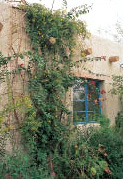
July: Vines need support.
Monitor all irrigation systems closely. Failure now without early detection can be a disaster.
Be sure to water trees deeply. Palms, especially, respond to slow, deep irrigation. Soaker hoses are inexpensive and easy to use. Summer heat is also a good time to plant or transplant palms and cacti.
When chlorosis shows on eucalyptus and other trees, treat with soil acidifiers. Ask your nursery for advice on current products.
Indoors, with air conditioning, begin planning for the fall, or plan a retrofit to make the garden more water efficient. And there’s hope: After July, it is only two months until the fall planting season, and the onset of cooler temperatures!
August
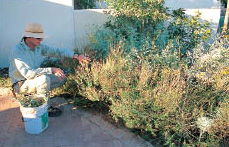
August: Trim Salvia greggii for more flowers in fall.
August is a near-repeat of July, only high temperatures seem to extend longer and higher humidity plays more of a role. Rains may or may not appear.
Remove dead basal foliage of perennials. Deadhead (trim or pinch off) spent flowers of coreopsis and rudbeckia.
Trim away dead flowering stems of Salvia greggii, autumn sage. This stimulates creation of new flowering stems for the fall and winter season. Likewise, lightly cut back old, tired stems of Salvia farinacea, blue salvia, to encourage new basal growth.
Time to make plans for fall planting of annuals and perennials. Order seeds of adapted wildflowers for planting in September and October. If weather is not too hot, prepare fall planting beds by digging organic materials into the top 8 to 10 inches of soil.
Rebuild basins on plants, especially on slopes, to hold in irrigation water. Check drip irrigation systems to see that they are operating correctly.
Continue to control unwanted Bermudagrass. If overseeding your Bermudagrass lawn, hold off on fertilizing—renovation and reseeding is just two months ahead. If not overseeding, then fertilize.
Green algae on the soil surface in the garden indicates excessive moisture. Check irrigation lines and hose bibs for leaks.
Hold off extensive shearing or pruning for another month. Pruning now may expose formerly shaded stems and foliage to sunburn.
September
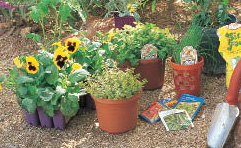
September: It's prime time to plant.
The 15th of this month launches the most important planting season of the year. Planting reaches its peak by October 15, when winter and spring annuals such as petunias, snapdragons and pansies are placed in their beds. This narrow window of time allows new plants to develop roots when the soil is warm before the cooler late fall and winter air temperatures slow plant growth. Sow seeds of wildflowers, set out trees, shrubs and perennials from containers. Plant bulbs and bulb cover such as sweet alyssum.
If renovating and reseeding lawn with annual or perennial ryegrass, slow down Bermudagrass growth by reducing irrigation and cease applications of fertilizer.
As part of soil preparation in flower and vegetable beds, add organic mulches and slow-release fertilizers.
If petunias, snapdragons and pansies have been planted continuously in the same soil for a number of years, apply a fungicide to prevent die-off problems with new plantings. Or plant these annuals in a new location, giving the old bed a rest.
Later in the month, as the path of the sun drops lower to the south, gradually taper off irrigation. However, continue to deep-water trees and shrubs. (See Irrigation Guide.)
October
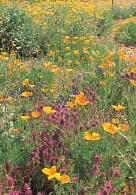
October: Sow wildflower seed for flowers in spring.
This is a month of sunny days, yet it’s usually comfortable to work in the garden. Plants are thriving, and planting of most everything continues through the month. However, hold off planting cold-tender tropical and subtropical plants such as citrus until spring, unless you have a microclimate at your home where plants are protected from wind and cold.
This is the month to turn your home landscape into a showplace. Everything is in your favor. The weather is mild and nurseries are loaded with fresh plants in containers, flats and pots. Well-rooted seedlings adjust readily to transplanting during this season. Moisten soil prior to planting. Water plants in gently after planting and continue to water regularly as they begin to become established. Avoid excessive moisture. Dig down into the soil with a trowel to a depth of 6 inches to make sure moisture penetration is adequate.
Continue to overseed Bermudagrass lawns until mid-October.
October is the best time to sow wildflower seeds, but you can continue up until mid-November. How to establish wildflowers is given in the annuals section. Water planting beds well before sowing seeds.
November
Continue fall planting if you missed the October period. Plants will establish slower with cooler temperatures.
Apply high-nitrogen fertilizer to ryegrass-seeded lawns to spur health and green color as days shorten and colder nights slow growth.
Bring cold-tender plants in containers under shelter to protect from freezing temperatures.
By November, many perennials such as rudbeckia and gaillardia that flower from summer into fall have completed their bloom cycle. Cut back to basal growth and clean up leaf debris.
Chrysanthemums are in their prime. Cut flowers to use for bouquets. This also helps flowering branches from drooping excessively.
During October, November and into December, Texas rangers are in bloom. This makes it a good time to select plants by flower color by visiting your nursery. More than a dozen selections are now available.
Roses usually enter winter dormancy, although they may continue to bloom until severe frost. Keep soil moist. Wait to prune in late January or early February.
Hold off pruning or thinning citrus until after flowering ceases in spring.
December
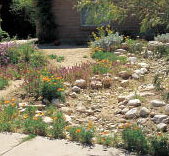
December: Time to do the heavy work, such as installing a dry creek bed for landscape interest and drainage.
This is a great month to take advantage of the delightfully mild winter weather, and tackle those major garden projects. Here’s a list of ten things to do in the December garden:
- Install a drip irrigation system complete with weather-based irrigation controller. It will save water throughout the coming year.
- Plant perennial and bulb gardens to replace beds of annuals—saving water, money and time spent on maintenance.
- Develop a wildlife garden in a corner of the yard to attract birds, bees, butterflies and small critters.
- Grow plants in colorful pots you decorate yourself to give as holiday gifts.
- If your landscape has drainage problems, create a drainage swale, and if possible, include a retention basin. Or build a simulated creek bed with rocks and boulders to channel and disperse runoff.
- Make a rock garden on a natural-shaped, flowing mound to serve as a landscape feature. Plant nooks and crannies with flowering perennials, ground covers, ornamental grasses and accent plants.
- Reduce the size of large lawns, especially in front yards. Give the space to water-efficient ground covers.
- Build a raised bed garden to grow a vegetable or color garden. Incorporate ample amounts of organic matter into the soil to provide your plants with optimum growing conditions.
- If you have an old garden with woody hedges and overgrown plants, consider giving it a face lift. Remove tired plants and bring new ideas into play with colorful, water-efficient, low-maintenance plants.
- If there is a large expanse of gravel or other inert ground cover surrounding your home, replace some areas with low-water-use ground covers and shrubs. Plants located at the base of structures cut down on reflected heat and light on the outside of buildings to help reduce cooling costs inside.
